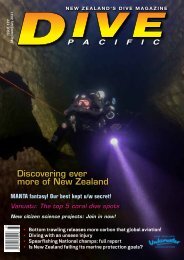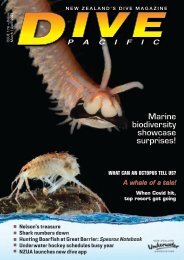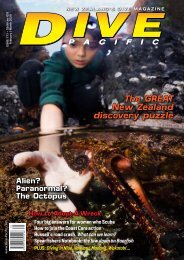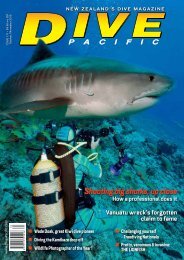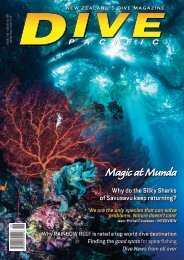Dive Pacific 175 Dec2020 Jan 2021
Dive Pacific, New Zealand's Dive Magazine , captures the best of diving in New Zealand and the Pacific. with adventures, top photos and expert technical advice
Dive Pacific, New Zealand's Dive Magazine , captures the best of diving in New Zealand and the Pacific. with adventures, top photos and expert technical advice
Create successful ePaper yourself
Turn your PDF publications into a flip-book with our unique Google optimized e-Paper software.
With an expression of sheer ecstasy, a tigress hugs an ancient Manchurian fir, rubbing her cheek against<br />
bark to leave secretions from her scent glands. She is an Amur, or Siberian tiger in the Land of the Leopard<br />
National Park in the Russian Far East, found only in this region, with a small number surviving over the<br />
border in China and possibly a few in North Korea. The population is threatened by poaching and logging<br />
which also impacts their prey, mostly deer and wild boar. Low prey densities mean tiger territories are huge.<br />
Sergey installed his first proper camera trap in <strong>Jan</strong>uary 2019, opposite this grand fir. But it was not until<br />
November that he achieved this picture, of a magnificent tigress in her Siberian forest environment. Nikon<br />
Z-7 + 50mm f1.8 lens; 1/200 sec at f6.3; ISO 250; Cognisys camera-trap system.<br />
The fox that got the goose by Liina Heikkinen,<br />
Finland Winner 2020, 15-17 years old,<br />
Young Grand Title Winner<br />
On a summer holiday in Helsinki, Liina, then aged<br />
13, heard about a large fox family living in the<br />
city suburbs on the island of Lehtisaari. The foxes<br />
are relatively unafraid of humans, and Liina and<br />
her father spent one long July day watching the<br />
two adults and their six large cubs. It was 7pm<br />
when the vixen arrived with a barnacle goose,<br />
and feathers flew as the cubs fought over it. One<br />
finally dragged it into a crevice to block access to<br />
the others. Lying just metres away, Liina was able<br />
to frame the scene and capture its expression.<br />
Nikon D4 + 28–300mm f3.5–5.6 lens; 1/125 sec at<br />
f5.6 (-0.3 e/v); ISO 1600.<br />
A tiny diamondback squid paralarva flits in the blackness, stops when caught in the light beam, gilds<br />
itself in shimmering gold then moves gracefully out of the light. The beam was Songda’s on a night‐dive over<br />
deep water off the coast of Anilao in the Philippines. All sorts of larvae and other tiny animals migrate up<br />
from the depths under cover of night to feed on surface-dwelling phytoplankton, and after them come other<br />
predators. A paralarva is the stage between hatchling and subadult, already recognizable as a squid, here 6–7<br />
centimetres long.. Chromatophores (organs just below the skin) contain elastic sacs of pigment that stretch<br />
rapidly into discs of colour when the muscles around them contract. Iridophores deeper in the skin reflect<br />
and scatter light, adding an iridescent sheen. Songda captured the fleeting moment when the diamondback<br />
paralarva turned to gold.<br />
The golden moment by Songda Cai, China<br />
Winner 2020, Under Water<br />
www.dive-pacific.com 49




